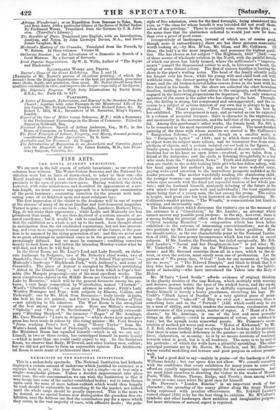FINE ARTS.
THE ROYAL ACADEMY EXHIBITION.
We are now in the full season of artistic luxuriance ; as our crowded columns bear witness. The Water-Colour Societies and the National In- stitution were but as lines of dawn-cloud, to usher in their sun—the Royal Academy—which rose above the horizon yesterday at two o'clock precisely to the eyes of private-view-goers. Having watched the dawn, however, with some minuteness, and described its appearances at a cer- tain length, we must reserve any approach to a telescopic examination of the great luminary ; contenting ourselves for the present with indi- cating some of its brightest spots and most refulgent rays.
The first impression of the visitor to the Academy will be one of regret at the absence of many of its most familiar and best-honoured magnates. Turner is gone—never to come back ; Eastlake, Landseer, Herbert, Dyce, Egg, do not make their appearance ; while Leslie and Mulready are less prominent than usual. We are thus deprived of a certain amount of as- sured excellence ; but it would be rash to conclude from these premises that the exhibition as a whole is not up to the mark. Less thought about in anticipation than the old established reputations, but not less interest- ing, and even more important because prophetic of the future, is the posi- tion to be assumed by the rising generation of art : and this we never saw to so great advantage in individual cases as in the present year, or more promisingly diffused. But we must be summary ; confining ourselves merely to such hints as will inform the intending Monday-visitor what he will find, and where he will find it.
In the Great Room are Mr. Lucy's Lord and Lady Russell, an elabo- rate landscape by Redgrave, two of Mr. Roberts's chief works, two of Stanfield's, three of Webster's—the largest "A School Play-ground "— Mulready's landscape "Blackheath Park," with Anthony's and some of Creswick's. The place of honour is occupied by Maclise's astonishing "Alfred in the Danish Camp" ; not very far from which is Cope's Gri- Beide (the Marquis proposing)—one of his most excellent works. The most conspicuous objects in the Middle Room are Creswick's "Mountain Lake by Moonrise," which will be the general favourite among his pic- tures; a very large composition by Winterhalter, named " Florinde" ; Ward's "Charlotte Corday "—a great advance in colour; Frith's Lady Wortley Montague and Pope ; with subjects by Elmore, Collins, and Pickersgill ; one by Mr. Hook from Boccaccio— truly lovely in parts, the best he has yet painted; and Poole's from Pericles Prince of Tyre —not satisfying to his admirers. The West Room is the stronghold of the best among our younger men. Here are Millais's wondrous " Ophelia" and "Eve of St. Bartholomew," Hunt's equally extraordi- nary "Hireling Shepherd," the immense " Hagar " of Mr. Armitage, Mr. Cave Thomas's "Laura in Avignon "—which shows how much pro- gress has been made in colour by this rising painter—Mr. Ford Brown's 'Jesus washing Peter's feet,' a dingy 'Henry Taylor" from Mr. Watts's hand, and the best of Pickersgill's contributions. Thorbum in the Miniature Room has equalled himself—which is all we can say : Linnell, in two or three rooms, has outstripped himself in poetic beauty —which is more than one could easily expect to say. In the Sculpture Room, we observe that Bally, MiDowell, and other leading men exhibit ; but we did not get time to form an expressible opinion. The A;chitectu- ral Room is more scant of architecture than ever.


























 Previous page
Previous page